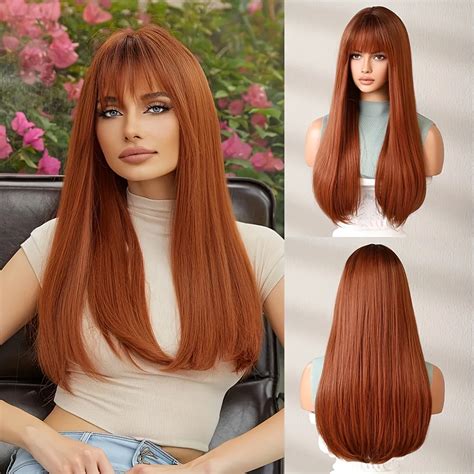Introduction
Wigs have become an integral part of the beauty and fashion industry, offering countless options for hair transformations. Whether you’re looking to switch up your style, conceal hair loss, or create a character for a special occasion, there’s a wig out there to suit every need. This comprehensive guide will delve into the diverse range of wig types, their construction, and their unique characteristics.

Synthetic Wigs
1. Kanekalon Wigs
- Material: Kanekalon, a synthetic fiber that closely resembles human hair
- Characteristics: Soft and silky with a natural shine, heat-resistant up to 400°F (204°C)
- Uses: Fashion wigs, cosplay, and hair enhancements
2. Toyokalon Wigs
- Material: Toyokalon, a high-quality synthetic fiber known for its durability
- Characteristics: Extremely resilient, heat-resistant up to 350°F (177°C), holds curls better than other synthetics
- Uses: Wigs for everyday wear, professional styling, and hair prosthetics
3. Monofiber Wigs
- Material: High-performance monofilament fiber that mimics human hair
- Characteristics: Ultra-fine and virtually indistinguishable from real hair, heat-resistant up to 370°F (188°C)
- Uses: Premium-quality wigs for natural-looking transformations
Human Hair Wigs
4. Remy Human Hair Wigs
- Material: Human hair that has been processed to retain its natural cuticle alignment
- Characteristics: Luxurious, silky, and long-lasting, blends seamlessly with natural hair
- Uses: High-end wigs for everyday wear, special occasions, and hair extensions
5. Non-Remy Human Hair Wigs
- Material: Human hair that has not been processed to maintain cuticle alignment
- Characteristics: Affordable and less durable than Remy hair, may have some tangling and shedding
- Uses: Everyday wigs, budget-friendly styling options, and hair toppers
6. Lace Front Human Hair Wigs
- Construction: Human hair wigs with a lace front that mimics the natural hairline
- Characteristics: Virtually undetectable, provides a realistic and seamless transition
- Uses: High-quality wigs for film, television, and special events
Lace Wigs
7. Transparent Lace Wigs
- Material: Transparent lace that blends with any skin tone
- Characteristics: Creates a natural-looking hairline, suitable for all hair colors
- Uses: Professional-grade wigs for film, television, and stage productions
8. HD Lace Wigs
- Material: Swiss lace that is highly transparent and durable
- Characteristics: Virtually invisible under makeup, provides a flawless hairline
- Uses: Premium-quality wigs for special events, red carpet appearances, and photo shoots
9. T-Part Lace Wigs
- Construction: Lace wigs with a T-shaped section at the crown that allows for hair parting
- Characteristics: Versatile and easy to style, provides a natural-looking hairline
- Uses: Everyday wigs, hair replacement, and fashion styling
360 Lace Wigs
- Construction: Lace wigs with a full 360-degree lace cap
- Characteristics: Provides full coverage and customization, allows for high ponytails and updos
- Uses: Versatile wigs for everyday wear, special occasions, and hair loss solutions
Application Methods
10. Glue-In Wigs
- Method: Wig is attached to the scalp using a strong adhesive
- Characteristics: Secure and long-lasting, but can cause skin irritation and hair damage
- Uses: Professional wig installations, special events, and hair loss solutions
11. Tape-In Wigs
- Method: Wig is attached to the natural hair using thin, double-sided tape
- Characteristics: Less damaging than glue-in wigs, can be removed and reapplied easily
- Uses: Everyday wigs, hair volume enhancements, and hair loss solutions
12. Clip-In Wigs
- Method: Wig is secured to the natural hair using clips
- Characteristics: Temporary and easy to apply, suitable for occasional use or special occasions
- Uses: Hair extensions, hair volume boosters, and color transformations
Styling and Maintenance
- Tips for Styling: Use heat-friendly wigs for styling with hot tools, avoid using high heat settings, and condition regularly to maintain softness.
- Maintenance: Clean wigs regularly with mild shampoo, avoid using harsh detergents, and store wigs properly to prevent tangling.
- Lifespan: The lifespan of a wig varies depending on the material, construction, and care. Synthetic wigs typically last around 3-6 months, while human hair wigs can last up to 1-2 years with proper care.
Innovative Applications
- Wigs for Accessibility: Wigs can provide a transformative solution for individuals with alopecia, trichotillomania, or other hair loss conditions, boosting self-confidence and promoting well-being.
- Wigs for Creativity: Wigs are essential in the entertainment industry, allowing actors, performers, and drag performers to embody diverse characters and create immersive experiences.
- Wigs for Fashion: Wigs are a powerful accessory in the fashion world, enabling individuals to experiment with new hairstyles, colors, and textures to express their individuality and creativity.
Industry Statistics
- The global wig market is projected to reach $17.02 billion by 2027, growing at a CAGR of 5.5% during the forecast period.
- According to a study by the American Hair Loss Association, over 50% of women will experience some form of hair loss in their lifetime.
- Synthetic wigs account for approximately 60% of the global wig market, with human hair wigs making up the remaining 40%.
Conclusion
Wigs have come a long way from their humble origins. Today, they are a versatile and transformative tool for self-expression, hair enhancement, and hair loss solutions. With countless types of wigs available, individuals can find the perfect match to suit their unique needs and preferences. Whether you’re looking for a temporary hair boost or a full-fledged hair transformation, there’s a wig out there waiting to unleash your inner style icon.
